|
|
||||||||||||
Stephen Toulmin, an English philosopher, developed a practical approach to analyzing the logic of everyday arguments. His approach involves identifying and separating the various components of an argument into a specific order so that they may be appraised. The model and specific vocabulary that Toulmin employs will be elaborated as required.
| Back to Top |
In its most simple form an argument consists of a claim (C), which is the conclusion to be established by the argument. We have already seen that arguments consisting of only a claim or conclusion are Level 1 arguments. Examples would include:
· Vitamins are good for you.
· Breast self-examination saves lives.
· Mrs. Smith should take hydrochlorothiazide.
These claims, on their own, lack any reasoned support to determine whether
they are true or false despite the fact that they may be true or false.
More is required to establish this.
| Back to Top |
As arguments are intended to persuade you on the truth or probability of some matter, there is some unresolved issue or decision on which the provision of information depends. When attempting to demonstrate the truth or probability of an argument's claim, one may be asked: "What information have you got to go on?"
The first step to establishing a claim is to have some information that justifies it. Claims are usually supported by appeal to some facts or other considerations. Broadly considered these can be called data (D). Data can be a direct observation, appeal to published literature or any other form of positive or negative information.
During your discussions with Mrs. Smith she may question why she should take hydrochlorothiazide. The response to her question is that she suffers from hypertension.
We can represent the components of this argument using the format developed by Harley Dickinson:
 |
|
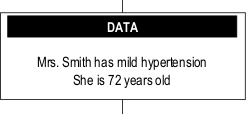 |
|
 |
|
| Back to Top |
Even after presenting data that acts as the foundation for an argument, you may be asked "How did you get there?". In other words, can you somehow justify the leap from the data you've provided to the claim?
Supporting the step between data and the claim is the warrant (W). A warrant is distinct from the data and the claim and acts as a bridge between them. The movement from data to the claim though the use of a warrant forms a Stage 2 argument. You should note that warrants are often implicit (i.e. left unstated) in arguments.
Mrs. Smith
may then ask why this particular medication. Essentially, you are being
requested to supply a warrant for your decision. Quite simply, you've
prescribed this medication because it is effective at lowering blood pressure.
 |
|
 |
|
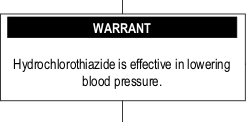 |
|
 |
|
| Back to Top |
One may call into question the validity of the warrant. To demonstrate the validity of the warrant it may be necessary to introduce additional data, information or possibly other arguments as backing (B) to a warrant.
You've told Mrs. Smith that hydrochlorothiazide will lower her blood pressure. But she may respond "How do you know?".
The range of possible answers available to you as her physician include the following:
1. Because I'm a doctor (intuition/authority)
2. Because in my experience it works (experience)
3. Because it interferes with a specific biochemical process that will
lower blood pressure (basic science)
4. Because many well designed studies have shown that the drug is effective
in lowering blood pressure (clinical science)
Clearly there is a wide variety of available
warrants for use in an argument with some being stronger than others.
With the use of stronger warrants we become more confident in the validity
of the argument and are more likely to accept the claim.
 |
|
 |
|
 |
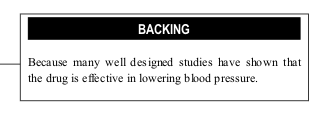 |
 |
|
| Back to Top |
As most arguments are not absolute in nature, Toulmin introduced qualifiers (Q) into his model as a way to express the relative strengths of warrants in supporting the conclusions that they justify. If a warrant allows us to unequivocally accept a claim given the appropriate data, we can qualify the claim with "definitely" or "necessarily". If there is any uncertainty surrounding the warrant we may be forced to qualify the claim with terms such as "probably" or "possibly". By convention the qualifier is considered separate from the warrant.
Taking hydrochlorothiazide does not necessarily
guarantee that blood pressure will be lowered. In this case we need to
qualify our warrant by stating that hydrochlorothiazide is usually effective
in lowering blood pressure.
| Back to Top |
A rebuttal (R) acknowledges limitations of the argument and may be put forward to indicate conditions in which the warrant is not applicable and consequently the conclusion can be overturned.
A rebuttal in the case of Mrs. Smith may be that she is currently on a medication that interacts with hydrochlorothiazide. A more efficacious medication may be suggested and thus act as a rebuttal. Perhaps Mrs. Smith's particular set of values, whatever they may be, prevent her from using the medication.
With the introduction of qualifiers and the search for counterclaims
and rebuttals, the Toulmin model can be used to analyze more complex Stage
3 and 4 arguments such as those commonly encountered in the practice of
medicine.
| Back to Top |
Relation to Evidence Based Medicine
Currently there is much controversy among the proponents and critics of evidence-based medicine in regards to the role of external evidence, individual clinical expertise and data from the individual patient in the clinical decision making process. Harley Dickinson has illustrated the role of such information in the clinical context through the use of Toulmin model of argumentation.
Dickinson argues that when introduced in argument information can either be "warrant-using" or "warrant-establishing".
Warrant-using information acts as the basis for a conclusion and attempts to answer "What information do you have to go on?". In the clinical context, warrant-using information relates to the individual patient and is obtained through the patient interview, physical examination and investigative tests. In the case of Mrs. Smith, warrant-using information would include the measurement of her moderately elevated blood pressure on physical examination.
Warrant-establishing information serves as the backing or justification of the warrant used to make the leap from the data to the conclusion. Essentially, this form of information is used to answer "How did you get there?". In relation to evidence-based medicine, warrant-establishing information is typically derived from systematic research such as randomized controlled trials and meta-analysis. However, clinicians may often find themselves in situations where there is little, if any, research data available. In such situations clinicians may use clinical expertise as their warrant.
In the case of Mrs. Smith warrant-establishing information would include randomized controlled trials that demonstrate the effectiveness of hydrochlorothiazide in lowering blood pressure.
Research evidence does not necessitate a clinician to make a particular
decision. Evidence is not the absolute truth as it relates to the particular
group of people participating in research studies. When we generalize
from evidence obtained from a study to our patients we are simply improving
our confidence in using a particular warrant.
| Back to Top |
Preference and greater weight is given to studies with less apparent bias such as randomized controlled trials and meta-analysis. Separate hierarchies of study designs have been developed for therapy/prevention, prognosis and diagnosis. Of the five levels of evidence, level I evidence is considered the freest of bias. Physicians should look to use the highest available evidence from the hierarchy.
The Centre
for Evidence Based Medicine provides a document discussing the hierarchy
of evidence and grades of recommendation.
| Back to Top |
Case One - Acute Bronchitis and Antibiotic Use
Ms. Carter, a 54-year-old non-smoking woman, presents with acute bronchitis and requests antibiotic therapy. Her condition is most likely viral in etiology and you deny her request for antibiotic medication. You develop a treatment plan focussed on supportive measures.
 |
|
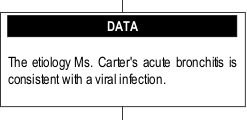 |
|
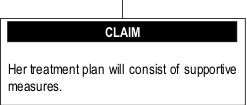 |
|
She demands an explanation for the treatment plan you've developed. You inform her that antibiotics are ineffective in treating acute bronchitis of viral etiology.
 |
|
 |
|
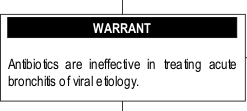 |
|
 |
|
She still insists on you prescribing the medication and says that she always gets antibiotics when she is sick and they always make her feel better. In support of your warrant you refer to the findings of several clinical and basic science studies and discuss how prescribing antibiotics in this situation could help promote the proliferation of antibiotic resistant bacteria.
 |
|
 |
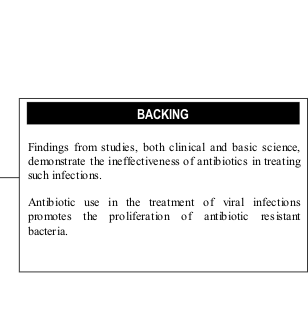 |
 |
|
 |
|
| Back to Top |
Mr. Jones, a 68-year-old smoker, has come to your office today to learn the results of a series of diagnostic tests that were performed recently. You inform him that the test results are indeed positive for esophageal cancer and that it is well developed. You discuss his prognosis and outline a treatment plan. As his cancer has become well developed you propose that the mainstay of his therapy be pain management.
 |
|
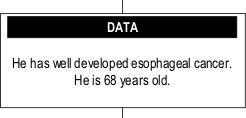 |
|
 |
|
Mr. Jones understands that he has cancer but is confused as to why he
can't undergo surgery or chemotherapy as treatment options. He asks you
why the cancer won't be treated directly. In essence, Mr. Jones is asking
you to provide a rationale or warrant for your decision. You may respond
that "Esophageal cancer that is as well developed as his is usually
terminal".
 |
|
 |
|
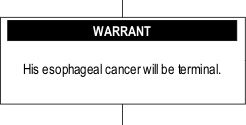 |
|
 |
|
Mr. Jones may question your warrant by asking "How do you know that?".
You are being requested to provide backing to your warrant. Mr. Jones
is not interested in warrant-using information but rather warrant-establishing
information. You may respond by referring to research studies that show
no statistically significant differences in survival rates among men his
age and with condition receiving treatments such as chemotherapy, surgery
and radiation when compared to pain management.
 |
|
 |
|
 |
 |
 |
|
| Back to Top |